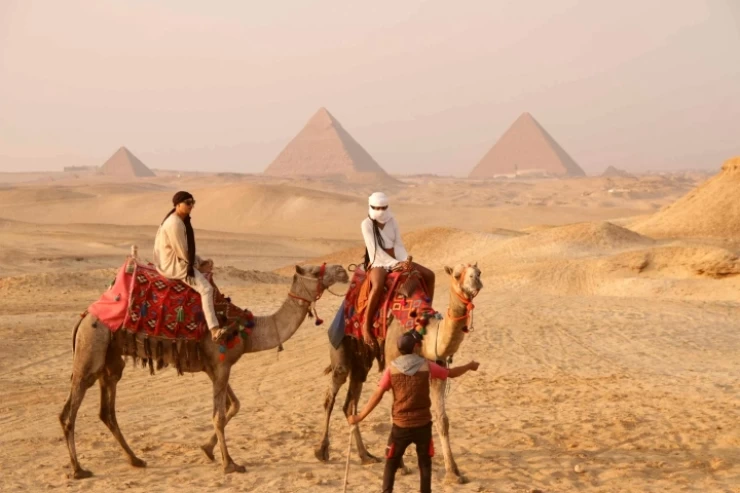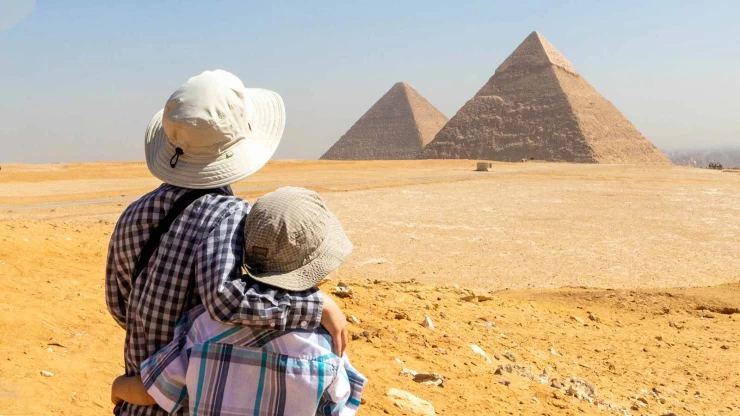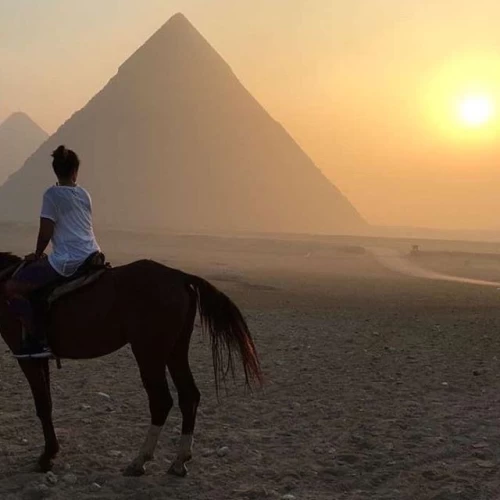
Piramidi d'Egitto | Piramidi dell'Egitto

Piramidi d'Egitto
Le piramidi egiziane sono antiche strutture egiziane a forma di piramide. Dal novembre 2008, le fonti hanno stimato il numero di piramidi egiziane a circa 118 o 138. Durante l'antichità e il Medioevo, la maggior parte di esse furono costruite come tombe per gli antichi faraoni e i loro dipendenti.
Le più antiche piramidi egiziane conosciute si trovano a Saqqara, a nord-ovest di Menfi.
Piramidi dell'Egitto
La più antica di queste piramidi è la piramide a gradoni del re Djoser, costruita tra il 2630 e il 2610 a.C. durante la Terza dinastia. Creata dall'architetto Imhotep, questa piramide e la collezione circostante sono generalmente considerate le più antiche strutture massicce al mondo costruite da lavori di costruzione.
Tra le piramidi egizie più famose ci sono quelle nel Governatorato di Giza, alla periferia del Cairo. Molte delle piramidi di Giza sono tra le più grandi strutture mai costruite al mondo. La piramide di Khufu a Giza è la più grande piramide egizia. È l'unica delle sette meraviglie del mondo antico ancora esistente.
una delle sette meraviglie del mondo rimaste fino ad ora fatta da umani e fino ad ora abbiamo molte opinioni diverse per scienziati e ricercatori su cosa sia la piramide e come costruirla ma se guardiamo indietro e vediamo la prima piramide il passo piramide e seguito le teorie e le loro tracce sapremo molti segreti e come costruire questo grande edificio
La seconda piramide egizia storicamente documentata è attribuita all'architetto Imhotep, che progettò quella che gli egittologi credono essere una tomba per il faraone Djoser. Si attribuisce a Imhotep essere il primo a concepire il concetto di impilare le mastabe una sopra l'altra, creando un edificio composto da un numero di "gradini" che diminuivano di dimensioni verso il suo apice
Il risultato fu la costruzione della Piramide di Djoser, progettata per essere una gigantesca scala attraverso la quale l'anima del defunto Faraone poteva ascendere al Cielo, e questo era il suo piano per raggiungere il suo scopo, che i defunti egizi deificarono dopo di lui.
Molto tempo dopo la fine del periodo di costruzione delle piramidi in Egitto, in quello che è l'attuale Sudan si è verificata un'esplosione di piramidi, dopo che gran parte dell'Egitto è passata sotto il dominio del Regno di Kush, che allora aveva sede a Napata.
Mentre il dominio di Napatan fu breve e terminò nel 661 a.C., la cultura egizia fece un'impressione indelebile. Il periodo meroitico della storia kushita, quando il regno era centrato su Meroë, (approssimativamente nel periodo tra il 300 a.C. e il 300 d.C.), vide una vera e propria rinascita della costruzione di piramidi, che vide più di duecento piramidi reali indigene di ispirazione egizia -tombe costruite nelle vicinanze delle capitali del regno.
Si ritiene che la forma delle piramidi egizie rappresentasse la collina primitiva in cui gli egiziani credevano che la terra fosse stata creata, e si ritiene che la forma della piramide rappresenti la luce solare discendente. lontano.
Le piramidi erano spesso chiamate anche in modi che si riferivano alla luminescenza solare. Ad esempio, il nome formale della Piramide Piegata a Dahshur era La Piramide Splendente Meridionale, e quello di Senwosret a el-Lahun era Senwosret è Splendente.
Nel 1842, Carl Richard Lipsius pubblicò il primo elenco moderno di piramidi - ora noto come "Elenco delle piramidi di Lipsius", che contava il numero di piramidi in 67 piramidi, e un altro grande numero è stato scoperto da allora, a partire dal novembre 2008 , 118 numero di piramidi egiziane sono stati determinati. L'ultima piramide da scoprire è stata quella di Sesheshet a Saqqara, madre del faraone Teti della sesta dinastia, annunciata l'11 novembre 2008.
Tutte le piramidi d'Egitto, ad eccezione della piccola piramide della Terza Dinastia, si trovano nell'angolo dei morti (o nell'angolo dei morti), sulla riva occidentale del Nilo, e la maggior parte di esse sono raggruppate in una serie di campi piramidali. I più famosi di questi sono elencati geograficamente, da nord a sud, di seguito.
Abu Rawash
Giza
Zawyet el-Aryan
Abusir
Saqqara
Dahshur
Mazghuna
Lisht
Meidum
Hawara
el-Lahun
El-Kurru
Il nostro team vi aiuterà a viaggiare in Egitto e sperimentare il tempo soleggiato del nostro bel paese durante la Pasqua 2022, grazie alla loro vasta conoscenza del turismo egiziano. Puoi personalizzare il tuo pacchetto selezionando uno dei nostri pacchetti di viaggio in Egitto o sfruttare al massimo il tuo tempo in una breve visita, imparando di più sulla storia egiziana e le sue affascinanti storie e vivendola attraverso tour privati al Cairo. Partecipa a uno dei nostri tour economici in Egitto attraverso il deserto del Sahara, come i tour di Siwa dal Cairo, per esempio, o preferibilmente i tour nel Deserto Bianco d'Egitto. Scoprite i nostri tour di un giorno ad Assuan, fate una gita di un giorno da Assuan ad Abu Simbel, o viaggiate via terra e godetevi i nostri tour di un giorno a Luxor per vedere gli incredibili templi di Karnak, il Tempio di Luxor, il Tempio di Hatshepsut, e vedete le meravigliose tombe splendidamente dipinte nella Valle dei Re, questo è il luogo dove i re e i governanti del nuovo regno riposano in pace e imparate i loro riti di mummificazione e sepoltura.
Le piramidi di Giza sono chiamate necropoli di Giza. Il complesso piramidale di Giza si trova in un sito archeologico sull'altopiano di Giza, nella regione del Grande Cairo, in Egitto. Il complesso contiene la Grande Piramide, la Piramide di Khafre e la Piramide di Menkaure, insieme ai loro complessi piramidali associati e alla Sfinge. Tutte queste piramidi furono costruite durante la Quarta Dinastia dell'Antico Regno dell'antico Egitto, tra il 2600 e il 2500 a.C.. Il sito contiene anche diverse tombe e i resti di un villaggio di lavoratori. Le piramidi si estendono anche da Abu Rawash a Giza a Hawara, alla periferia di Fayoum. Si tratta di edifici reali e archeologici costruiti dagli antichi egizi nel periodo 2630 a.C.. E fino all'anno 1530 a.C. M. La sua costruzione è stata graduale, in quanto dalla prima piramide a gradoni, come la Piramide di Djoser (3630 a.C. - 2611 a.C.) a Saqqara, si è passati a una piramide inclinata e poi alla ben nota forma di piramide piena rappresentata dalle piramidi di Giza. Le piramidi furono costruite secondo le credenze degli antichi egizi per conservare la mummia del faraone e aiutarlo nel suo viaggio nell'aldilà e nella sua ascesa al cielo. Anche il re Khufu costruì la Grande Piramide per seppellirlo, e gli antichi egizi credevano che lo spirito del re avrebbe continuato a prendersi cura di loro anche dopo la loro morte, per poi ascendere al cielo e unirsi al resto degli dèi; quindi avrebbe potuto nutrire i vivi sulla terra inviando la piena del Nilo, la crescita e la prosperità, e impedire loro il male. I nostri esperti vi assisteranno da qualsiasi aeroporto in Egitto e ovunque ne abbiate bisogno.
Positioned at an elevation surrounded by sand hills, one can easily understand why the pyramids found in Egypt are one of the most recognizable structures quite literally in the whole world. It is perhaps impossible to get a person who has traveled, read, or even watched a documentary and not be captivated by these towering structures that have stood the test of time for centuries. Their beauty and how they were constructed leave no one indifferent and is the primary reason historians, regardless of age, travel to ancient countries. With that being said, let us go back in time to study the greatness of the pyramids in Egypt, why they matter historically, and what impact, if any, they made for future generations.
A Glimpse into Ancient Egypt’s Architectural Genius
From a historical perspective, the magnificence of the pyramids reveals the creativity and architectural skills of the ancient Egyptians. These great edifices, built as shrines for the kings and emperors to symbolize their godly power, display the heightened level of engineering, mathematics, and astronomy acquired by the Egyptians.
These pyramids were not simply built to contain and protect the preserved corpses of kings and queens. They were designed along the lines of doorways or rather turned off to be concerned with the interior, the beyond. The ancients believed that their kings would not only reign over them in this world but also in the next, and so the pyramids were constructed to provide fit accommodations for their wandering spirits. So too with the physical body of the pharaoh, riches, provisions, and ritual items were interred to assist the person’s transition to everlasting life.
The Great Pyramid of Khufu
Due to several centuries of exposure, the pyramid stands at only about 138 m in height, which is still considerable.
The Great Pyramid is estimated to have contained more than 2.3 million stone blocks, with several characters feasible weighing one hundred tons, and considering this, it could be said that the pyramid strategies are among the engineering marvels of the ancient world. Even how the Egyptians would have managed to cut, transport, and assemble the huge blocks remains a mystery—some say that ramps or even cranes had been employed, yet others say that only brute strength sufficed; others propose the use of intellect.
The Pyramid of Khafre
Khafre’s Pyramid, also known as the tomb of Khafre the Son of Pharaoh Khufu, is one of the many structures situated in the Giza plateau region. Even though Khafre's pyramid is shorter than his father's, he seems to dwarf his father’s pyramid because of its placement on higher ground and, more importantly, a large part of the upper part of the pyramid, which has the original smooth casing stones that have survived the weather elements, giving the impression of a much bigger structure. All the pyramids had this layer, made of glossy Tura limestone that was so well polished it was almost glass; hence all of them glittered in the sun.
In addition, the Pyramid of Khafre features the Great Sphinx of Giza, found at the front of the pyramid. The Great Sphinx, which possesses the head of a man and the body of a lion, is carved from a singular piece of limestone and is largely assumed to symbolize Khafre. This giant figure, which is positioned at the front of the pyramids, piques curiosity towards the Giza complex even more.
The Pyramid of Menkaure
Out of the three pyramids in Giza, the smallest is undoubtedly the Pyramid of Menkaure, erected for Khafre’s son, Pharaoh Menkaure. However, this pyramid stands out because part of its casing is made of granite instead of the common limestone used for most well-known pyramids. This material, coupled with the pitch and height of the pyramid, suggests that Menkaure had ambitions of being remembered with the other great kings of Egypt.
Although the Pyramids of Giza are perhaps the most well-known, they are by no means the only pyramids in Egypt. Pyramids were built throughout the Nile Valley at various stages of Egyptian history and in different architectural styles, as well as for different purposes.
The Pyramid of Djoser
The Pyramid of Djoser is considered to be one of the oldest pyramids ever made and can be located in the Saqqara region with its necropolis. This step-designed tomb was built for Pharaoh Djoser by his architect Imhotep, who is mostly regarded as one of the creators of all pyramids to come. Rather than a smooth-sided infinite tower, Djoser’s pyramid is made of six terraced levels with an interesting layered look. This was a great milestone in the age of building pyramids, and it is still one of the most frequent places in Egypt.
The Bent Pyramid and the Red Pyramid
Another well-known location for pyramids is Dahshur, which features the Bent and Red Pyramids, both constructed by Pharaoh Sneferu. The Bent Pyramid stands out due to its unique design since the angles of the sides bend in the middle of the pyramid. This shaped more than a simple pyramid, and it was probably because of some problems encountered while building the pyramid. Nevertheless, it was not much later that Sneferu attempted to build his second pyramid, now called the Red Pyramid, and this one was much more successful than the first, for it became the first true pyramidal structure on a smooth surface within the territory of Egypt.
The massive blocks were maneuvered using ramps, sleds, and some levers. But there are other theories regarding the construction of the great pyramids that are more advanced than this; for instance, aliens coming to earth and building the pyramids, but so-called ‘crazy’ theories are generally not accepted by scholars.
There have been new studies that have come up with such things as the discovery of the workers’ villages and the tools, which also assist in helping people understand the construction of the great pyramids much more than before. Evidence goes against the perception of slavery, for it appears that pyramid builders were given food and shelter, and their work was appreciated.
The geometric understanding of a pyramid, characterized by a wider base that tapers to a point at the top, was designed to represent the rays emitted by the sun as the dead pharaoh was believed to rise and join the sun god, Ra, in death. The position of the pyramids north and south of the equator as well as their alignment with the constellations embodies the Egyptians’ firm belief in the connection between the sky and the land of the living.
Inside the pyramids, spaces, and corridors were typically built with the purpose of housing the pharaoh’s body while also serving as a means to help the spirit cross over. The insides of many pyramids were embellished with inscriptions called Pyramid Texts that consisted of spells for helping the hereafter of the pharaoh. Even though most of the valuables and objects that were kept in these pyramids have been taken away or destroyed over the years, the pyramids themselves are forever embodiments of the Egyptian faith of existence after death.
The Legacy of the Pyramids
The pyramids of Egypt have had a lasting impact on the course of history, in as much as they can be compared to any other structure. The dimensions of the pyramids, their architectural intricacy, together with the enigma surrounding the periods of their construction have motivated several generations of humankind. In the present, those structures attract awe to innumerable people every year who want to see with their own eyes one of the most magnificent monuments created in ancient history.
Besides the appreciation of the pyramids as significant cultural and historical treasures, these structures have also become icons of human determination and creativity. Their position on the skyline of the desert of Egypt evokes memories of a culture that, many millennia ago, was capable of creating marvels that still amaze people today.


















